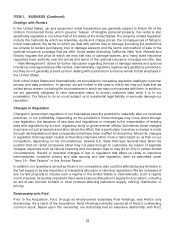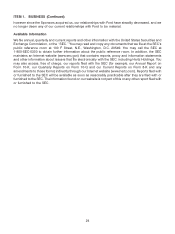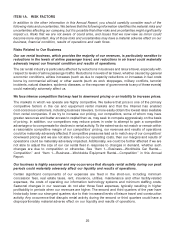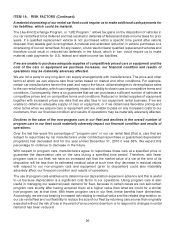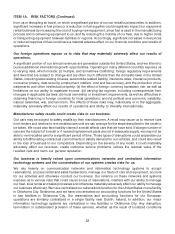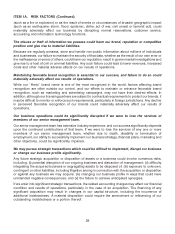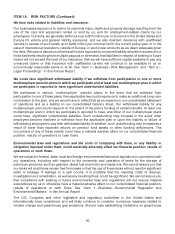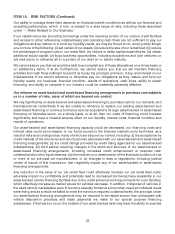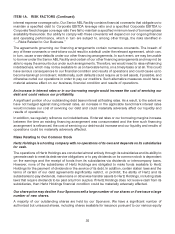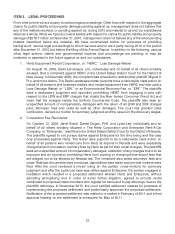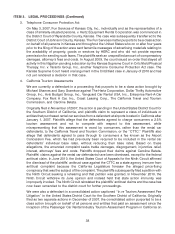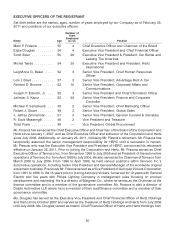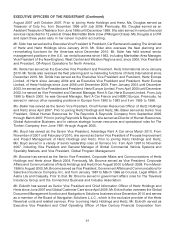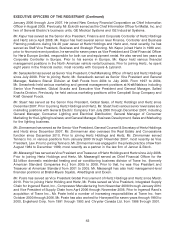Hertz 2010 Annual Report Download - page 56
Download and view the complete annual report
Please find page 56 of the 2010 Hertz annual report below. You can navigate through the pages in the report by either clicking on the pages listed below, or by using the keyword search tool below to find specific information within the annual report.ITEM 1A. RISK FACTORS (Continued)
a result control our management and policies. Moreover, the Sponsors will continue to have significant
influence over matters requiring stockholder approval and our policies and affairs for so long as the
investment funds associated with or designated by the Sponsors continue to hold a significant amount
of our common stock, even if this amount is less than a majority. There can be no assurance that the
interests of the Sponsors will not conflict with those of our other stockholders. The Sponsors currently
have the ability to prevent any transaction that requires the approval of stockholders, including many
possible change in control transactions, regardless of whether or not our other stockholders believe that
such a transaction is in the company’s or their own best interests.
Additionally, the Sponsors may from time to time acquire and hold interests in businesses that compete
directly with us. One or more of the Sponsors may also pursue acquisition opportunities and other
corporate opportunities that may be complementary to our business and as a result, those opportunities
may not be available to us.
We are currently a ‘‘controlled company’’ within the meaning of the rules of the New York Stock
Exchange (‘‘NYSE’’) and therefore we are not required to comply with certain corporate governance
requirements of the NYSE. If we cease to be a controlled company within the meaning of the NYSE rules,
then the stockholders agreement with the Sponsors provides that, if required to comply with the NYSE
rules, the number of directors that each of the funds is entitled to nominate may be reduced, or the board
may be expanded. However, certain other provisions of the stockholders agreement will remain in effect,
and we will continue to be subject to the stockholders agreement.
Risks Related to Our Substantial Indebtedness
Our substantial level of indebtedness could materially adversely affect our results of operations,
cash flows and ability to compete in our industry.
As of December 31, 2010, we had debt outstanding of $11,306.4 million. Our substantial indebtedness
could materially adversely affect us. For example, it could: (i) make it more difficult for us to satisfy our
obligations to the holders of our outstanding debt securities and to the lenders under our various credit
facilities, resulting in possible defaults on, and acceleration of, such indebtedness; (ii) limit our ability to
refinance our existing indebtedness or borrow additional funds in the future; (iii) require us to dedicate a
substantial portion of our cash flows from operations to make payments on our debt, which would
reduce our ability to fund working capital, capital expenditures or other general corporate purposes;
(iv) increase our vulnerability to general adverse economic and industry conditions, including interest
rate fluctuations, because a portion of our borrowings are at floating rates of interest and are not hedged
against rising interest rates; (v) place us at a competitive disadvantage to our competitors that have
proportionately less debt or comparable debt at more favorable interest rates or on better terms; and
(vi) limit our ability to react to competitive pressures, or make it difficult for us to carry out capital
spending that is necessary or important to our growth strategy and our efforts to improve operating
margins. While the terms of the agreements and instruments governing our outstanding indebtedness
contain certain restrictions upon our ability to incur additional indebtedness, they do not fully prohibit us
from incurring substantial additional indebtedness and do not prevent us from incurring obligations that
do not constitute indebtedness. If new debt or other obligations are added to our current liability levels
without a corresponding refinancing or redemption of our existing indebtedness and obligations, these
risks would increase. For a description of the amounts we have available under certain of our debt
facilities, see ‘‘Item 7—Management’s Discussion and Analysis of Financial Condition and Results of
Operations—Liquidity and Capital Resources—Credit Facilities,’’ in this Annual Report.
32



